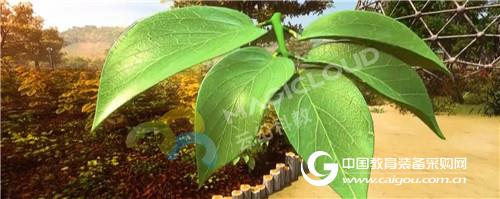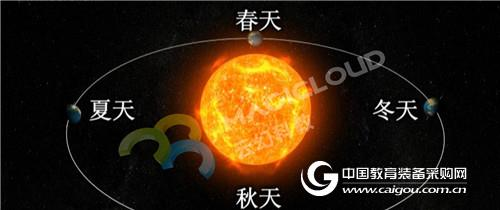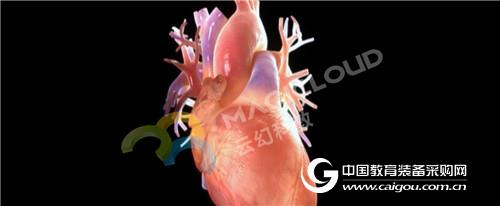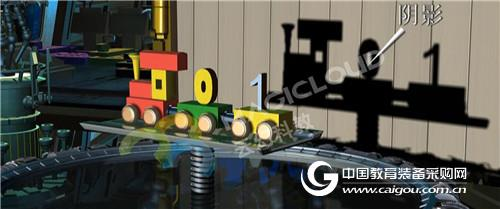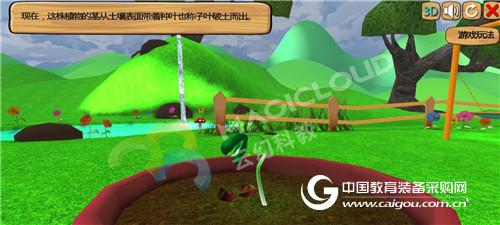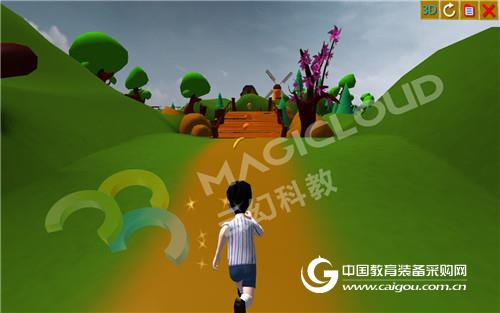introduction In February 2017, the Ministry of Education promulgated the "Compulsory Education Primary School Science Curriculum Standards", requiring full understanding of the importance of primary school science education, adjusting the initial grade of the primary science curriculum to the first grade, and requiring all localities to guide teachers to attach importance to experimental teaching. Promote students' active participation and active inquiry, and cultivate students' innovative spirit and practical ability. This paper mainly explains what kind of characteristics of the elementary science curriculum under the new curriculum standard. How does 3D teaching exert its teaching advantages such as vivid and interesting, three-dimensional image, encourage practice and innovation, and fully apply it to the implementation of primary school science. 3D teaching has obvious advantages in the abstract concept, the phenomenon that is too macroscopically difficult to observe, the phenomenon that is too difficult to observe, the phenomenon that the process is too fast to observe, and the phenomenon that the process is too slow and difficult to observe. 3D teaching has interactive practice links. The virtual environment encourages students to practice several times, which is in full compliance with the form of inquiry-based learning activities in the scientific implementation of the new curriculum standard. I. Characteristics of the new curriculum standard science curriculum (1) Science curriculum is offered to cover all stages of primary school The original science curriculum was opened in the third to sixth grades of elementary school. In order to improve the overall scientific quality and cultivate the scientific spirit from a young age, the newly issued Compulsory Education Primary School Science Curriculum Standard clearly requires that the initial grade of the primary science curriculum be adjusted to the first grade. In principle, Courses are arranged at no less than 1 class per week in the first and second grades of elementary school. (2) Science curriculum content added technology and engineering field The science curriculum content adds new technology and engineering content on the basis of the original material science, life science, earth and space science. Among the four fields, 18 main concepts suitable for primary school students are selected, including 6 in the field of material science, 6 in the field of life sciences, 3 in the field of earth and space science, and 3 in the field of technology and engineering. The three new themes in the field of technology and engineering are: 1. People create a colorful and artificial world in order to make production and life more convenient, fast and comfortable; 2. The core of technology is invention, and people are on nature. Utilization and transformation; 3, the key to engineering technology is design, engineering is the use of science and technology to design, solve practical problems and manufacture products. (iii) The main form of science curriculum implementation is inquiry activity The newly promulgated Compulsory Education Elementary Science Curriculum Standards requires that the implementation of science curriculum should emphasize the subjective status of students, protect students' curiosity and curiosity, and use inquiry-based learning as the main form of implementation. Inquiry-based learning refers to the learning method that allows students to actively participate, move hands, experience positively, experience scientific inquiry, acquire scientific knowledge, comprehend scientific thoughts, and learn scientific methods under the guidance, organization and support of teachers. Schools are required to highlight the creation of a learning environment, providing students with more self-selected learning spaces and full inquiry-based learning opportunities. Under the new curriculum standard, the implementation of primary science will face how to better understand the world around the world, understand abstract concepts, and understand the connections between phenomena. For some phenomena that change too fast or change too slowly, how to explain the phenomenon that is too macroscopically difficult to understand or too microscopically difficult to understand; how to use the surrounding environment to implement inquiry-based teaching will also be the challenge for the implementation of primary science. Second, the application of 3D teaching in the implementation of the science curriculum in primary schools (1) Stereoscopic image showing abstract knowledge points The elementary science curriculum of the new curriculum contains 18 topics in four major areas, many of which are abstract and difficult to understand. For example, explain how the various parts of plants in the life sciences help plants to maintain their respective functions of survival, and talk about the breathing and photosynthesis of leaves. These phenomena are difficult to observe by the naked eye. The third-grade students can only explain the abstract concept of teachers. Learning is not good. If you use the Cloud Magic 3D teaching resources, it is totally different. Through the 3D video "Leaf of Plants", the leaves of plants are analyzed one by one, and the three-dimensional image of the veins, breathing mouth, oxygen and carbon dioxide exchange process, which are difficult to observe by the naked eye, is displayed, which not only improves the attention of the students, but also improves the attention of the students. Greatly improve the knowledge of students. In addition to the above-mentioned functions of plants to maintain their own survival, there are many abstract knowledge points that can be explained through the 3D teaching of Yunhua Science and Education. For example, understanding the food chain, the stratification of the atmosphere, electrical energy, and the like. (2) Simulating realistic scenes showing excessive macro or micro phenomena There is a large area in the elementary science curriculum of the new curriculum for the field of earth and space science, and the content inside is too macroscopic and difficult to observe. For example, how to understand the relationship between the Earth, the Moon and the Sun, how to understand the Earth's rotation and its climate change brought to the Earth. In traditional teaching, it is usually explained in the form of a globe, a drawing or a part of 2D video. Through the display and interaction of the resources of the 3D teaching resources "The Planet in the Solar System", "Day and Night Alternation", "The Sun in the Sky", "The Moon", etc., students can be placed in space for an interplanetary journey. . In the life science field, for example, students should understand that “the human body is composed of multiple systems, and the division of labor and cooperation to sustain life activitiesâ€. Students should fully understand the body's constituent system and its operating mechanism. When explaining the basic parts of the human body such as the hands, feet, body, head, etc., it can be perceived and observed, and the students can easily understand. However, when it comes to the human body's blood circulation system, nervous system and other knowledge, it is difficult for students to understand because it is too difficult to observe its operation. Through the resource demonstration and interaction of the 3D teaching resources of "Cloud - a magical pump", "Breathing and Circulatory System", "Nervous System", students see each part of the heart, how the blood circulation is from the right atrium The tricuspid valve enters the right ventricle and then enters the pulmonary artery. This three-dimensional image, step-by-step explanation of the operational mechanism, not only attracts students' interest, but also allows students to quickly master what they have learned. (3) Reproduce the changing scene of the flash or the slow speed of the flash In the content of the science of science and science in the elementary school of the new curriculum, the study of related knowledge such as light energy, electric energy, and sound energy. Because light and electricity travel very fast, it is difficult for the naked eye to observe the record, and the sound propagation is too abstract and unobservable. If you only explain it from words and pictures, it will take more time for students to understand and master. Through the demonstration and interaction of resources such as Light and Shadow, Light and Shadow, and Sound Propagation, the fast-moving scenes will be reproduced in slow motion for students to understand. At the same time, electricity, light, sound, etc. are represented by visible lines, and students will have a better understanding of these knowledge points. There are also some phenomena that need to be observed for a long time. Through the regular demonstration of 3D resources, not only can we observe the development of things, but also save time. For example, "plant growth", "animal life cycle" and so on. (4) The multi-form fun interaction of cartoon images encourages students to explore Inquiry-based learning is the main form of implementation of the science curriculum in primary schools. Schools should use all kinds of resources to create an inquiry-based learning environment. The 3D teaching resources of Yunhua Science and Education include exploration interaction and practice evaluation. Through the lively and cute cartoon image, the students can interact in colorful scenes and quickly attract students' attention. Because virtual inquiry allows multiple attempts, there is a very large trial and error inclusiveness, giving students more opportunities to practice inquiry. Through 3D teaching, the science curriculum in primary schools can be more vivid, and students can be more interactive and teachers can be more excited. Third, the conclusion Based on visual 3D modeling, 3D education integrates 3D image, VR, AR, MR, 3D printing and other technologies through project learning to complete the complete learning and cognitive process from “creative to realizationâ€. “Hands and brains†is an innovative education that develops students' interdisciplinary learning ability, teamwork ability and digital expression ability. 3D education is not only suitable for the implementation of the science curriculum of primary schools, but also for the classroom implementation of subjects in biology, physics and chemistry in junior high schools. 3D education is a new mode of wisdom education and an inevitable development trend of audiovisual education in the future. As a leader in 3D education, Yunhua Science and Education will continue to develop 3D resources and curriculum design, so that more students become beneficiaries of 3D education. Ningbo DSS Intelligent Technology Co., Ltd , https://www.dssking.com